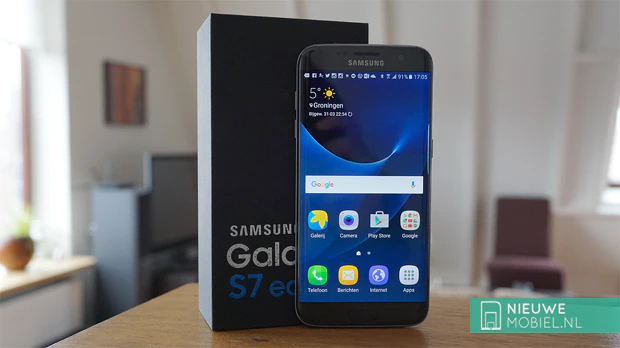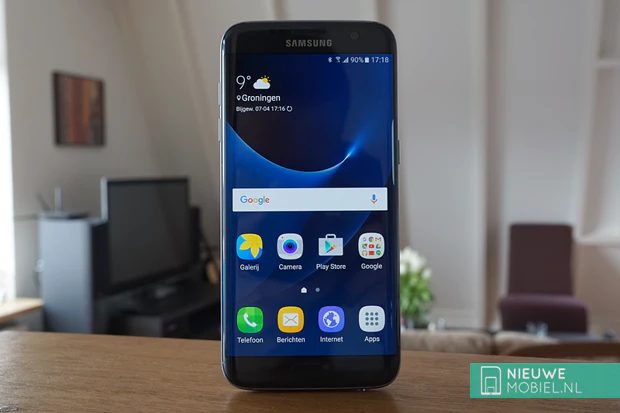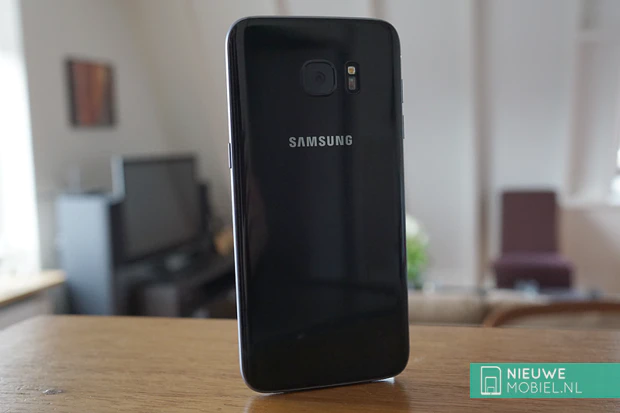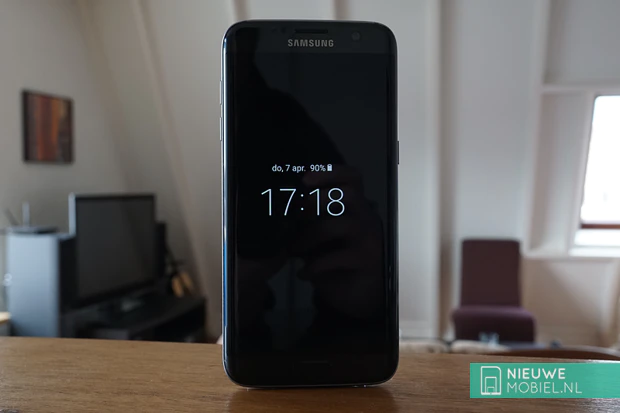Samsung Galaxy S7 edge review
On the verge of perfection?
On the eve of the past MWC, Samsung presented two new S7 devices. Of those two, we have now tested the curved S7 edge.

This time Samsung did not choose to completely change the design for the S7 line. Instead, Samsung embroidered on the good aspects of the S6 line and further refined its appearance. Of course the hardware has also been upgraded. Think of the processor, camera and a larger screen.
Content of the box
Headset
microUSB cable
Plug
USB adapter
With a 5.5-inch display, the S7 edge is between the S6 edge and S6 edge+ and may therefore become an interesting option for more people. Next to the edge there is the regular S7 with a 5.1 inch screen.
Other manufacturers also presented their new flagships at the MWC. Like the LG G5 and HTC later with the 10. Earlier the iPhone 6s Plus, Nexus 6P and Sony Xperia Z5 premium were launched. All large and pricey smartphones with more or less special features that Samsung with the S7 edge would like to give it a look.
Design
The S7 line therefore shows clear similarities with the S6 line but has been further improved in detail. Also for the S7 (edge) the Black Onyx version tested by us is available again. Both S7's are a fraction thicker than their predecessor(s) but you hardly notice that when holding them. The battery capacity, on the other hand, does benefit considerably. The front and back are still made of glass with a metal rim around the device. The metal is matte and slightly convex at the top and bottom. There is no sharp edge or right angle anywhere on the device anyway. Also the transitions from glass to metal have been smoothed.

At the front, of course, the screen immediately catches the eye. Because of the edges, the screen really seems folded around the device and the edges next to the screen are also very thin. Above and below the screen there is not much empty space either. Besides a small grill for the speaker and the self-image camera, there are a number of sensors and a small notification light above the screen. Beneath the screen is the physical home button, which also functions as a fingerprint scanner, with a touch-sensitive back button and button for recent apps on either side. Strangely enough, Samsung is still changing the position of these last two compared to pure Android and many other manufacturers. You get used to it pretty quickly, but it's also a bit of an unnecessary complication.
On top of the device is the slot for the SIM card where there is room for a microSD card. An infrared transmitter is no longer present. At the bottom we find, as usual, the ports for the headset and microUSB. Samsung does not opt for USB-C because Samsung's virtual reality glasses, the Gear VR, also have a microUSB connection. The speaker is also located at the bottom. In that spot, you can quickly cover it with a finger when you hold the device horizontally.
Just like on the S6 there are no lids for openings anywhere on the S7 edge. Nevertheless, this time it is dust- and waterproof. That's a good thing because it doesn't detract from the ease of use. However, the quality of the loudspeaker is a little less. The sound is a bit more tinny and a bit distorted.

At the back, the camera still protrudes a bit but considerably less than the S6. Next to the camera is a single LED flash and the heart rate sensor. An important difference with the S6 is that the back is now rounded at the sides. Although less than the front, the camera is noticeably more comfortable to handle. The back is very smooth and a real stain magnet. It is also far from immune to scratches. If we were to buy an S7 edge, we would seriously consider applying a skin or cover on the back.
Performance
Compared to the S6 line, the battery capacity of the S7 (edge) has improved considerably. This is a step that we welcome with open arms. The S7 edge has a battery of 3600 mAh and that's quite generous for a device with a 5.5 inch screen. Of course, this should also power a powerful processor and large screen resolution, but we had high expectations. With the necessary ease we were able to fill a 36 hour usage time and get 6 hours of screen on time from the S7 edge. We mainly used WhatsApp, social media, two email addresses and the camera. So a long, intensive day should be no problem at all and two days can also be considered feasible.



".
The S7 edge can be charged wirelessly and with the included cable fast charging is on by default. In over 1.5 hours, the battery of the S7 edge is completely full again. During rapid charging, the device can become quite warm. If you do not like this, you can also turn the fast charging off. This time you can also quickly charge the device wirelessly. That was missing last year.



".
There are two versions of the S7s on the market worldwide with the only difference being a different processor. In the United States this is Qualcomm's Snapdragon 820 and in Europe Samsungs own Exynos 8 Octa. According to some reports the Exynos processor should be a bit faster in use and therefore good news for Dutch consumers. In addition, the device also has 4 GB of working memory. This makes multitasking a piece of cake. Once in a while the device seemed to freeze and didn't react anymore to input via the touchscreen. This could be solved by pressing the home or on/off button.
Display
The screen of the S7 edge again has a QHD resolution of 1440 x 2560 pixels. With a pixel density of 534 PPI on the 5.5-inch large screen, this of course results in an enormously detailed image. Additionally, this is an AMOLED panel, and Samsung has pretty much perfected the application of such screens. The color reproduction on the S7 edge is therefore very vivid, but not excessive. There are several screen modes available, but we did not find it necessary to adjust it.



".
Just like the back, the front is very sensitive to fingerprints and the glass is quite reflective. This can sometimes make it difficult to read. Because the screen is curved, you can look at the sides at an angle. As a result, colours fade a little and a blue gleam can be seen at the edges of a white surface. This blue glow is also visible over the entire screen when the device is not held completely straight.

An Always On mode is also available for the screen. Instead of turning the screen off completely, it can be used to display a clock, calendar or picture. This happens on a mostly black screen so the AMOLED screen uses as little power as possible. Unfortunately, the functionality is rather disappointing in what we know of Motorola and Nexus devices. On the Samsung, however, there are only icons for missed calls and received SMS messages, and not for email or WhatsApp, for example. It is to be hoped that the functionality will be further expanded in the future. Until then, you can also turn Always On Display off.



".
Software
The S7 edge runs on the latest version of Android but that's not immediately obvious. Since time immemorial, Samsung has been putting its own skin over Android and for almost as long there has been a lot of criticism on this interface. Samsung has already cleaned up and tightened up Touchwiz, but there are still some peculiarities in it. In addition to the appearance of the interface, Samsung has also often been criticized for the number of extra apps installed and their limited usefulness. This has improved a lot, but there are still double apps for email, app store, internet, photos and voice control on the device. There are also Microsoft Office apps and Skype.



".
The bright green and blue of the quick settings above the notifications has given way to dark blue and light grey. Using themes, the color palette and icons in the interface can be adjusted. For example, settings menu The theme with Android 6.0 looks was an instant favorite with us. Unfortunately it is not possible to combine themes. For the start screens, the grid size can be adjusted. This way more shortcuts fit in the image and better use is made of the screen resolution.


A split screen functionality can be activated from the overview of recently used apps. It does not work for all apps but a large part of them. On the 5.5 inch screen you have just enough space to use it comfortably. Apps can also be displayed in a floating screen by dragging down from a top corner. This can only often happen accidentally when you want to open the notification screen.


".
The application menu is a separate case with TouchWiz. By default it covers one page where apps from Google, Microsoft and Samsung are grouped into folders. Instagram, Facebook and WhatsApp are also grouped together in one folder. The sorting of the other apps is rather arbitrary. When you remove apps from a folder or install new apps, they are placed at the back of the grid and new pages are created that need to be browsed horizontally.


The menu can also be sorted by alphabet with a button at the top of the screen. Then you can save this sorting. Apps in folders are not included. However, newly installed apps will not automatically be sorted by alphabet, but will appear at the very end of the menu. Then you have to manually create and save the sorting by alphabet again or put the app itself in the right place.
When you remove an application from the device, there is a hole at the end of that page in the menu. Icons from the next page do not connect automatically. Same as iPhones, but totally inconsistent with Android. The apps that are on the device by default cannot be uninstalled but can only be turned off. As a result, they are invisible and not directly usable.
As avid users of various Android phones, we notice these kinds of things but fortunately these annoyances can be solved by installing another launcher from the Play store.
Hardware
The S7 edge owes its name of course to the curved screen. Since this screen is larger than the normal S7 it is also a bit more expensive. So we are curious what functionality is hidden behind the 'edge'. It concerns three functions that respectively listen to the names windows, feeds and lighting. The last one is the easiest and ensures that the screen lights up when a call or message comes in. To do this, the phone just has to be placed with the screen down and we don't find that a very pleasant way to put our phone down. With feeds a news ticker can be shown when the screen is off with an overview of messages, news and/or the pedometer. To show this you have to swipe your finger back and forth over the side of the screen.



".
Windows is the functionality available when the screen is on and you are using the device. You can drag and drop a screen from the left or right and browse through different panels. The position, size and transparency of the button to open it can be adjusted. There are panels available for apps, tasks, people, my places, quick tools, internet, S planner and weather. Furthermore, a number of panels can be downloaded but some of these need to be paid for.



".
Apps and people are for shortcuts to applications and favorite contacts, respectively. With the task panel, specific functions of apps can be opened directly. Unfortunately, this only works for Samsung's own apps. My Places can offer certain functions based on your location and quick tools include a compass and centimetre. There are also panels for finance, sports and news. There is Dutch news available from NU.nl under the Edge window tab.



".
Despite the fact that the order of the panels can be adjusted, we found it useful to activate as few panels as possible in order to maximize the usability and clarity of edge. In addition, we should note that the edge also has its disadvantages, albeit minor ones. Sometimes the screen didn't react because we already touched the edge with the palm of our hand unnoticed. It also seemed more difficult to swipe the Android burgers menu from the left outside the screen. At the keyboard, keys sometimes fall just over the edge and this can lead to typing errors. What can help is to make the edge tabs smaller.



".
Like its predecessors, the S7 edge has a fingerprint scanner hidden in the home button on the front of the device. This is a convenient place because it is also accessible when the device is on the table. However, it seems to have a somewhat smaller surface area than the round or square scanner we see at other manufacturers. It is therefore necessary to place your finger or thumb accurately. It is possible to press the home button and unlock the device immediately afterwards, but this does not always go well. After three tries, the device already asks for a login code. If you are stubborn and don't get it right for two more minutes, you have to wait half a minute until you can unlock the device at all. In addition to unlocking the device, you can also use the scanner to log in to websites or your Samsung account.
Camera
The camera on the S7 went from 16 to 12.2 megapixels. However, it is of course not Samsung's intention to sacrifice in terms of image quality. The Koreans therefore use their own sensor, which is combined with an extra bright lens and an f/1.7 aperture. Additionally, Samsung introduces the Dual Pixel technique, in which every pixel can be used to focus.


The interface has not been changed dramatically and is very suitable for fast photography. In the search screen all the necessary settings can be adjusted such as effects, HDR, timer, flash and picture size. Furthermore, recording modes for car, pro, selective focus, panorama, video collage, live broadcast, slow motion, virtual recording, food and hyperlapse can be selected. Six additional modes can also be downloaded.


".
When recording video in 4K, HDR, autofocus tracking and effects are not available. The 5 megapixel self-image camera has a wide angle lens and also an f/1.7 aperture. There is a, almost exaggerated, extensive functionality available to brighten up your appearance and the screen can light up brightly as a flash.
In daylight, the camera of the S6 already performed very well and that is still the case on the S7 edge. Colors look realistic and also detail reproduction does not suffer from the reduction of the number of pixels. Striking strong point of the camera is the lightning fast autofocus. When taking photos as well as videos, this goes very smoothly and smoothly. In dark conditions you don't suffer much from noise, but the exposure is not always the best we have ever seen on a smartphone. For example, the Nexus 6P and Samsung Galaxy S6 sometimes show a more even exposure with more details. Another thing that does not make us very happy is that the aspect ratio went from 4:3 to 16:9. For video, this ratio works very well, but it is less suitable for photos. You can always manually set the size to 4:3, which results in a resolution of 6.2 megapixels (2,880 by 2,160 pixels).
Conclusion
Samsung took an interesting approach by not radically altering the new S7 devices compared to the S6 line. Many people liked the design and Samsung only improved it further. Moreover, waterproofness, support for microSD card and a larger battery have been added.
We have nothing more to complain about on the S7 edge about the speed or cumbersomeness of the interface. The software is streamlined and there are practically no more hiccups. Also the color palette has improved a lot. Despite this, we still ran into a number of inconveniences from Samsung that strike us as avid Android users. We find the application menu in particular an ordeal. Fortunately, Android allows us to remove a lot of annoyances by adjusting the interface.
As far as hardware is concerned, there are also a few small remarks to be made. The S7 edge is a very good phone and they may stand out even more. The sound of the single speaker is not very thunderous and you cover it quickly with a finger. Furthermore, the glass back gives very little grip and makes the phone a little more vulnerable. As far as we're concerned, you don't have to buy the S7 edge because of its edge functionality. Most of this we think has only limited added value. However, if you are looking for a compact and very nicely designed smartphone with a 5.5 inch screen, it is certainly a good option.

